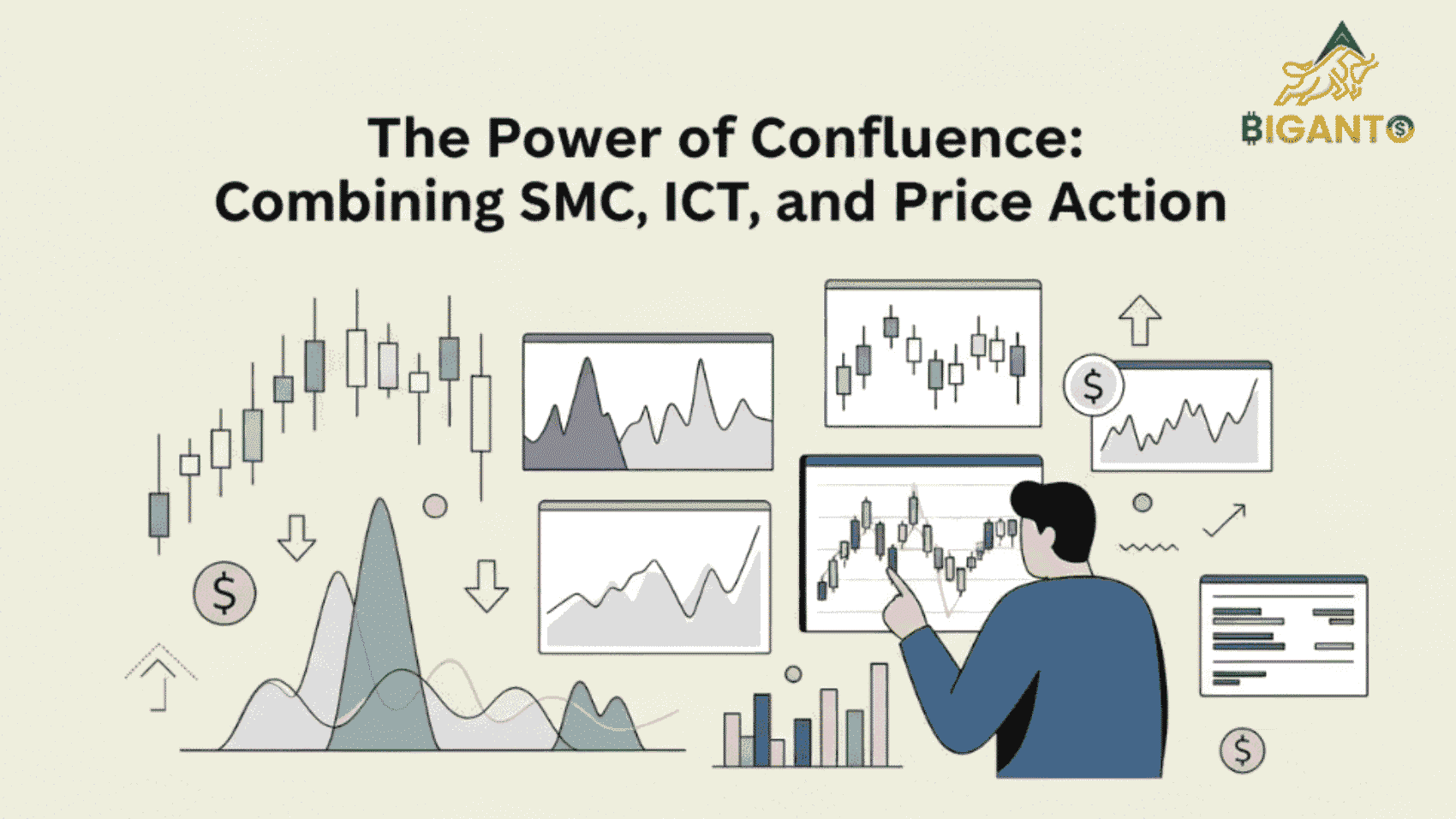Price action and confluence are the most potent combo a Forex trader can employ. Although it may seem audacious, there’s a valid rationale for it. Confluence is the process of combining several confirmations prior to making a trade.
Traders wait for many approaches to align, such as price action trading strategies, ICT (Inner Circle Trader) concepts, and Smart Money Concepts (SMC). By learning this through the best trading course or joining Forex and crypto classes, you can improve your consistency and discipline.
Confluence in trading refers to several indications that coincide at the same price or market state, increasing the conviction of a trade position. such as when the price hits a specific level and the candlestick pattern for trading using an ICT fair value gap (FVG) and an SMC liquidity sweep respectively.
These signals helps Forex Traders or any any trader to find high probability setups.
Foundation of trading Price Action
Analyzing a security’s past price movements to inform trading decisions without the use of complicated models or lagging indicators is known as rading with price action.
Key elements and their tools
Levels of support and resistance where prices typically reverse
Candlestick patterns that indicate pressure to buy and sell Price opens, highs, lows, and closures are displayed using candlestick charts.
Channels and trend lines that show the direction of prices.
Patterns on charts that indicate potential future price movements A good charting program such as TradingView, which provides a basic version for free.
Volume that validates price movements It is employed to validate price movements.
Break of Structure (BOS) a shift in trend confirmed by new highs or lows.
Smart Money Concepts (SMC)
The idea that some investors, primarily institutions and seasoned traders (big money), possess superior knowledge and comprehension of the market is known as the smart money concept. The idea is that in comparison to retail traders, investors are thought to make more successful, strategic, and educated trades. Another name for retail traders is foolish money.
Key components of smart money concepts
Traders using the Smart Money concept often look for patterns that suggest where the big money is moving-
Areas where institutions join or quit significant positions are known as supply and demand zones.
Blocks of Order Prior to significant moves, prominent players fled consolidation zones. Keep an eye on the order book to spot big orders.
Grabs of Liquidity In order to ensnare retail traders before reversing, the price sweeps above or below important levels.
sentiment of the market assessing market sentiment to determine the potential placement of smart money.
Understanding and identifying key market structures like higher highs, lower lows, etc.
Recognizing areas where liquidity is likely to be, such as around previous highs/lows.
ICT Concepts
ICT focuses on understanding how the market operates, especially how institutional traders manipulate price to trap retail traders. ICT concepts emphasize the importance of market structure, liquidity pools, and manipulation of prices by institutional traders.
Key components of ICT Concepts
Price imbalances that serve as magnets for future price movement are known as fair value gaps, or FVGs.
Order blocks, fair value gaps, breaker blocks, and other PD arrays are the focus of ICT. We may locate trader entry by using the PD array.
Michael focuses claims that kill zones are where liquidity manipulations take place. As a result, we ought to hold off till the market sweeps liquidity.
The Power of Combining SMC, ICT, and Price Action
Individually, each strategy is powerful. But when combined, they form the best confluence trading strategy.
Support and resistance levels, candlestick patterns, trendlines, BOS (break of structure), and volume confirmation are all provided by price action. It displays the price’s unadulterated movement without any indicators.
The way that institutions function is shown by Smart Money Concepts (SMC). Market structure, order blocks, liquidity grabs, supply and demand zones, and other tools enable traders follow the moves of “big money” rather than becoming stuck like individual traders.
ICT Concepts improve accuracy. Following liquidity sweeps, traders can identify high-probability entry points with the use of institutional kill zones, PD arrays (order blocks, breaker blocks), and Fair Value Gaps (FVGs).
The likelihood of success rises sharply when all three coincide. As an illustration, the price creates a support level (Price Action) → A liquidity grab takes place (SMC) → A kill zone (ICT) is where an FVG entry forms.
Conclusion
If you’re looking for the best trading strategies, confluence is the edge you need. Whether in Forex, crypto, or the confluence in stock market, aligning multiple strategies is how professional traders stay profitable. Many Forex & Crypto traders combine institutional concepts like order blocks and fair value gaps with support and resistance forex levels to create a powerful forex confluence system. This makes confluence one of the best forex trading strategies for consistency. By combining SMC trading strategy, ICT forex concepts, and price action trading, you create a powerful confluence system that filters out weak setups and focuses on high-probability trades.
FAQs
- How do I avoid losses in forex trading with confluence?
You can reduce risk by combining support and resistance forex, candlestick patterns for trading, and SMC liquidity sweeps.
- Is ICT strategy and SMC the same thing?
Not exactly. Both focus on institutional trading concepts, but ICT adds precision tools like ICT kill zones forex and ICT FVG strategy, whereas SMC emphasizes order block trading strategy and liquidity grabs. Combining both creates the best confluence trading strategy.
- What’s better: Forex vs Crypto trading?
Both markets have pros and cons. Forex trading for beginners is often more stable, while crypto traders enjoy high volatility and opportunities. With confluence, you can adapt strategies to both.

